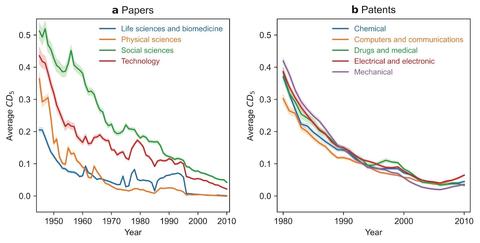
Science and Technology are Becoming Less Disruptive
Thursday, January 19, 2023
By Rose Semenov
Despite exponential growth in recent decades of research papers and patents, a new Carlson School of Management study published in Nature suggests science and technology are becoming less disruptive. The findings have generated media coverage worldwide, appearing in The New York Times, The Atlantic, The Economist, El País (Spain), ChosunBiz (South Korea), Le Monde (France) and more.
Carlson School Associate Professor Russell Funk, doctoral student Michael Park and Professor Erin Leahey of the University of Arizona analyzed data from 45 million papers and 3.9 million patents across six decades for their research. They used a “disruptiveness score," which is based on the patterns of citations five years after publication, to assess the extent to which papers and patents push ideas toward new trajectories. They determined:
- Papers and patents are less likely to be disruptive, or make previous findings obsolete and push science and technology in a new direction. (Ex: The discovery of the DNA double helix structure.)
- Instead, papers and patents are more likely to be consolidating, or further developing previous work. (Ex: The Kohn-Sham equation which improved upon existing equations about electron particles.)
- Scientists and inventors are increasingly using narrower slices of knowledge to develop their new work.
- This pattern holds across all major fields of science, including technology, medicine and social sciences.
“A healthy scientific ecosystem is one where there's a mix of disruptive discoveries and consolidating improvements, but the nature of research is shifting,” said Funk. “With incremental innovations being more common, it may take longer to make those key breakthroughs that push science forward more dramatically.”
For papers, the decrease in the disruptiveness score between 1945 and 2010 ranges from 91.9% for the social sciences to 100% for the physical sciences. For patents, the decrease between 1980 and 2010 ranges from 78.7% for computers and communications to 91.5% for drugs and medical.
One theory for the current trend is that all the “low-hanging fruit” of disruptive innovations have already occurred. The researchers also point to the growing burden of knowledge that scientists are required to learn, which means more time spent training rather than pushing the boundaries of science.
The researchers’ findings call for a need to reimagine how science is conducted. Scholars sometimes face a “publish or perish” research culture, in which their success is based on the number of papers they publish or patents they develop. The researchers suggest federal agencies could implement funding changes to better support scholars’ long-term careers.
“A lot of innovation comes from trying new things or taking ideas from different fields and seeing what happens,” said Park. “But if you are worried about publishing paper after paper as quickly as you can, that leaves a lot less time to read deeply and to think about some of the big problems that might lead to these disruptive breakthroughs.”
Despite the current trend, the researchers say it’s important to note this doesn’t mean there are fewer technological advancements to discover.
“There’s a huge need for innovation to find answers to today’s most pressing challenges—from climate change to space exploration,” said Funk. “It’s clear there are still huge opportunities for disruptive innovations to happen and to make improvements for humanity.”


